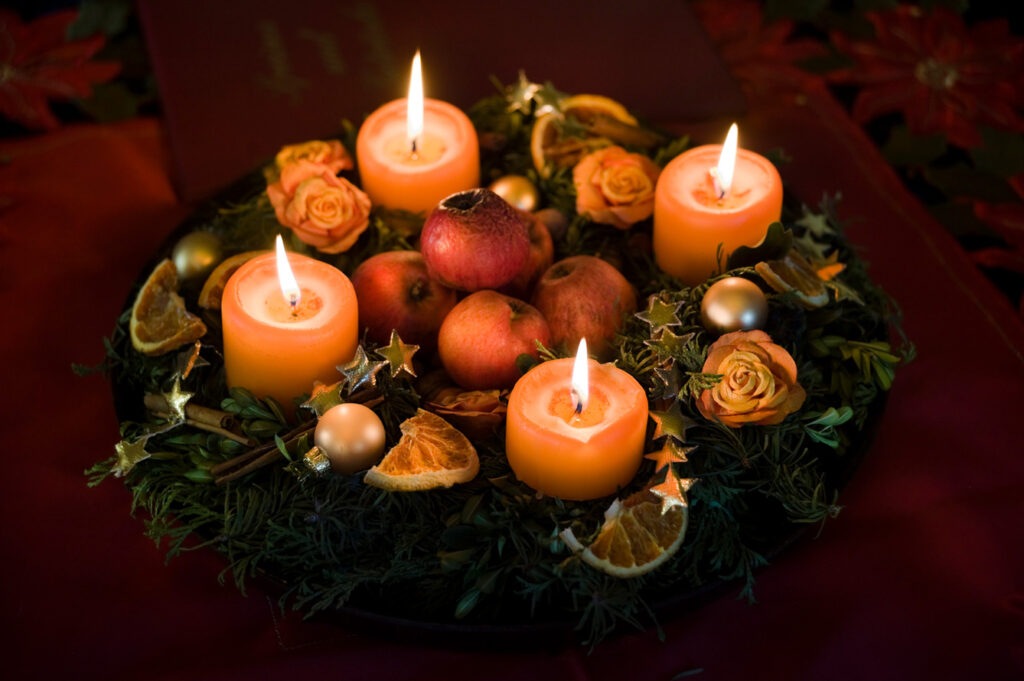It’s early December. The children eagerly count down the endless 24 days until that important date when the Baby Jesus (aka Czech Santa) makes his annual visit. But within those 24 days, many things happen.
The first important date is December 5, when St. Nicholas comes with an angel and a devil to give small presents to the children. The well-behaved kids get sweets, while the naughty ones get lumps of coal. Nowadays, it is a purely secular celebration that has no impact on the nation’s spiritual life. What’s more, many people don’t even know the legend of St Nicholas.
St. Nicholas also presents the children with a paper advent calendar with 24 windows. Behind each window, a small piece of chocolate is hidden. The children gradually open the windows and count down the days. The original aim of the Advent calendar was to remind adults and children of the events in the Bible. Today, it is all about chocolate.

Another object associated with Advent time is the advent wreath decorating most Czech households. The wreath is dominated by four candles, which are gradually lit with each Sunday of Advent. For most Czechs, however, it is a kind of decorative tradition. But no religious importance is usually connected with this tradition: it’s more about home aesthetics than religion.
To put it all into a broader perspective, we can mention a survey broadcast years ago on Czech TV. People were asked: “Do you attach religious/spiritual value to Advent calendars for children and Advent wreaths?” The short answer was “No”; the long answer was: “No, it’s just a plot by shops to sell more goods.“
Czech Christmas Eve: the food, the gifts, the TV
Christmas Eve is the unquestionable pinnacle of Christmas. In this respect, the Czech Republic is no different from other countries around. However, the actual course is different in most Czech households. Dinner is the most important event of the day when the entire family gathers. For many people, dinner is the first meal of the day. They fast from the morning to see the golden piglet, which brings them wealth in the coming year. Dinner is traditionally fried carp or chicken schnitzel with potato salad.
After dinner, when the children flee to their rooms – precisely when Baby Jesus (who brings presents in Czechia) arrives. After placing presents under the Christmas tree, he rings the bell to summon the children. This short episode is the second and final mention of Baby Jesus throughout Christmas in Czechia. It is also important to mention, however, that children and even adults sometimes do not know that the figure of Baby Jesus is identical to Jesus Christ. Most people see Baby Jesus (a young newborn Christ) as a different figure separated from Jesus Christ.
Then, the best part of the evening comes after the dinner and presents. What’s the best part? Do you think it’s midnight mass at the local parish church? Oh, no. The best part, after all, is watching the Christmas movies that often repeat year after year. Watching them is actually a tradition. And if people attend Midnight Mass, they do so only as a tradition, and they have no urge to participate in the activities connected with the Mass.
Tradition without tradition
Czech Christmas is a Christian holiday; only most Czech people don’t know about it. Most of the activities that Czechs do during Advent have origins in religious traditions and liturgy, but no one gives them such value. But this is understandable in a country that has endured many religious re-educations. First, there was the Hussite revolt and the suppression of Catholicism. Then, after the defeat of the Hussites, there was the radical re-Catholization of the Czech lands.
A more recent effort to “abolish” Christmas was the communist regime. The traditional Czech Christmas was to be replaced by a “Red” Christmas. What is Red Christmas? It’s Christmas when the workers, the proletariat, give gifts to each other. No Baby Jesus, no supernatural. Just redistribution within the working class.
You see, during those times, the Church was seen as the greatest enemy of the Communists.
It was banned, and everything connected with it was declared to be anti-state activity. When the communists realized that they could not abolish Christmas, they wanted empty its meaning. And in the current view, they have more or less succeeded. So Merry Christmas, and may Baby Jesus give you lots of presents!







